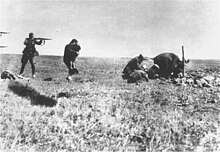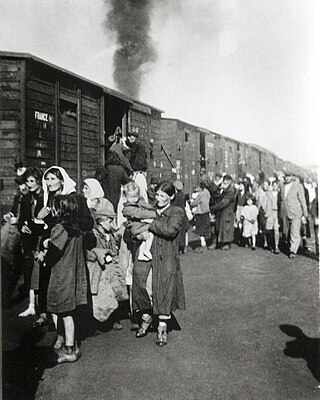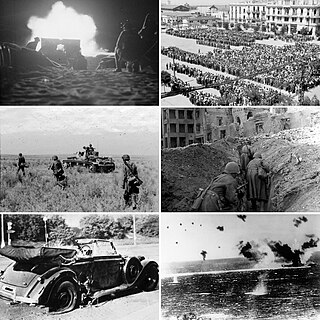Contents
| |||||
| Decades: | |||||
|---|---|---|---|---|---|
| See also: | Other events of 1942 History of Germany • Timeline • Years | ||||
Events in the year 1942 in Germany .
| |||||
| Decades: | |||||
|---|---|---|---|---|---|
| See also: | Other events of 1942 History of Germany • Timeline • Years | ||||
Events in the year 1942 in Germany .
Head of State and Chancellor

| | This section needs expansion. You can help by adding to it. (February 2011) |
| | This section needs expansion. You can help by adding to it. (February 2011) |

The Final Solution or the Final Solution to the Jewish Question was a Nazi plan for the genocide of individuals they defined as Jews during World War II. The "Final Solution to the Jewish question" was the official code name for the murder of all Jews within reach, which was not restricted to the European continent. This policy of deliberate and systematic genocide starting across German-occupied Europe was formulated in procedural and geopolitical terms by Nazi leadership in January 1942 at the Wannsee Conference held near Berlin, and culminated in the Holocaust, which saw the murder of 90% of Polish Jews, and two-thirds of the Jewish population of Europe.

Nazi Germany used six extermination camps, also called death camps, or killing centers, in Central Europe during World War II to systematically murder over 2.7 million people – mostly Jews – in the Holocaust. The victims of death camps were primarily murdered by gassing, either in permanent installations constructed for this specific purpose, or by means of gas vans. The six extermination camps were Chełmno, Belzec, Sobibor, Treblinka, Majdanek and Auschwitz-Birkenau. Extermination through labour was also used at the Auschwitz and Majdanek death camps. Millions were also murdered in concentration camps, in the Aktion T4, or directly on site.

Reinhard Tristan Eugen Heydrich was a high-ranking German SS and police official during the Nazi era and a principal architect of the Holocaust.

Treblinka was the second-deadliest extermination camp to be built and operated by Nazi Germany in occupied Poland during World War II. It was in a forest north-east of Warsaw, 4 km (2.5 mi) south of the village of Treblinka in what is now the Masovian Voivodeship. The camp operated between 23 July 1942 and 19 October 1943 as part of Operation Reinhard, the deadliest phase of the Final Solution. During this time, it is estimated that between 700,000 and 900,000 Jews were murdered in its gas chambers, along with 2,000 Romani people. More Jews were murdered at Treblinka than at any other Nazi extermination camp apart from Auschwitz-Birkenau.

Operation Reinhard or Operation Reinhardt was the codename of the secret German plan in World War II to exterminate Polish Jews in the General Government district of German-occupied Poland. This deadliest phase of the Holocaust was marked by the introduction of extermination camps. The operation proceeded from March 1942 to November 1943; around 1.47 million Jews were murdered in just 100 days from July to October 1942, a rate approximately 83% higher than the commonly suggested figure for the kill rate in the Rwandan genocide.

The Holocaust—the murder of about six million Jews by Nazi Germany from 1941 to 1945—is the best-documented genocide in history. Although there is no single document which lists all Jewish victims of Nazi persecution, there is conclusive evidence that about six million were murdered. There is also conclusive evidence that Jews were gassed at Auschwitz-Birkenau, the Operation Reinhard extermination camps, and in gas vans, and that there was a systematic plan by the Nazi leadership to murder them.

The Höfle Telegram is a cryptic one-page document, discovered in 2000 among the declassified World War II archives of the Public Record Office in Kew, England. The document consists of several radio telegrams in translation, among them a top-secret message sent by SS Sturmbannführer Hermann Höfle on 11 January 1943; one, to SS Obersturmbannführer Adolf Eichmann in Berlin, and one to SS Obersturmbannführer Franz Heim in German-occupied Kraków (Cracow).

Sonderaktion1005, also called Aktion1005 or Enterdungsaktion, was a top-secret Nazi operation conducted from June 1942 to late 1944. The goal of the project was to hide or destroy any evidence of the mass murder that had taken place under Operation Reinhard, the attempted extermination of all Jews in the General Government occupied zone of Poland. Groups of Sonderkommando prisoners, officially called Leichenkommandos, were forced to exhume mass graves and burn the bodies; inmates were often put in chains to prevent them from escaping.
The history of the Jews during World War II is almost synonymous with the persecution and murder of Jews which was committed on an unprecedented scale in Europe and European North Africa. The massive scale of the Holocaust which happened during World War II greatly affected the Jewish people and world public opinion, which only understood the dimensions of the Final Solution after the war. The genocide, known as HaShoah in Hebrew, aimed at the elimination of the Jewish people on the European continent. It was a broadly organized operation led by Nazi Germany, in which approximately six million Jews were murdered methodically and with horrifying cruelty. Although the Holocaust was organized by the highest levels of the Nazi German government, the vast majority of Jews murdered were not German, but were instead residents of countries invaded by the Nazis after 1938. Of the approximately 6 million Jews murdered by the Nazis, approximately 160,000 to 180,000 were German Jews. During the Holocaust in occupied Poland, more than one million Jews were murdered in gas chambers of the Auschwitz concentration camp alone. The murder of the Jews of Europe affected Jewish communities in Albania, Austria, Belarus, Belgium, Bosnia & Herzegovina, Channel Islands, Croatia, Czech Republic, Estonia, France, Germany, Greece, Hungary, Italy, Latvia, Libya, Lithuania, Luxembourg, Moldova, the Netherlands, North Macedonia, Norway, Poland, Romania, Russia, Serbia, Slovakia, and Ukraine.
Holocaust victims were people targeted by the government of Nazi Germany based on their ethnicity, religion, political beliefs, and/or sexual orientation. The institutionalized practice by the Nazis of singling out and persecuting people resulted in the Holocaust, which began with legalized social discrimination against specific groups, involuntary hospitalization, euthanasia, and forced sterilization of persons considered physically or mentally unfit for society. The vast majority of the Nazi regime's victims were Jews, Sinti-Roma peoples, and Slavs but victims also encompassed people identified as social outsiders in the Nazi worldview, such as homosexuals, and political enemies. Nazi persecution escalated during World War II and included: non-judicial incarceration, confiscation of property, forced labor, sexual slavery, death through overwork, human experimentation, undernourishment, and execution through a variety of methods. For specified groups like the Jews, genocide was the Nazis' primary goal.

Holocaust trains were railway transports run by the Deutsche Reichsbahn national railway system under the control of Nazi Germany and its allies, for the purpose of forcible deportation of the Jews, as well as other victims of the Holocaust, to the Nazi concentration, forced labour, and extermination camps.
Responsibility for the Holocaust is the subject of an ongoing historical debate that has spanned several decades. The debate about the origins of the Holocaust is known as functionalism versus intentionalism. Intentionalists such as Lucy Dawidowicz argue that Adolf Hitler planned the extermination of the Jewish people as early as 1918, and personally oversaw its execution. However, functionalists such as Raul Hilberg argue that the extermination plans evolved in stages, as a result of initiatives that were taken by bureaucrats in response to other policy failures. To a large degree, the debate has been settled by acknowledgement of both centralized planning and decentralized attitudes and choices.

This is a timeline of events that occurred during World War II in 1942.

The Grossaktion Warsaw was the Nazi code name for the deportation and mass murder of Jews from the Warsaw Ghetto during the summer of 1942, beginning on 22 July. During the Grossaktion, Jews were terrorized in daily round-ups, marched through the ghetto, and assembled at the Umschlagplatz station square for what was called in the Nazi euphemistic jargon "resettlement to the East". From there, they were sent aboard overcrowded Holocaust trains to the extermination camp in Treblinka.
This article presents the timeline of events at Treblinka extermination camp during the most deadly phase of the Holocaust in World War II. All deportations were from German occupied Poland, except where noted. In most cases the number of deportees are not exact figures, but rather approximations.

During World War II, Trawniki men were Central and Eastern European Nazi collaborators, consisting of either volunteers or recruits from prisoner-of-war camps set up by Nazi Germany for Soviet Red Army soldiers captured in the border regions during Operation Barbarossa launched in June 1941. Thousands of these volunteers served in the General Government territory of German-occupied Poland until the end of World War II. Trawnikis belonged to a category of Hiwis, Nazi auxiliary forces recruited from native subjects serving in various jobs such as concentration camp guards.
Georg Wilhelm Johannes Michalsen was a German SS-Sturmbannführer. During the Second World War, he was involved in the systematic deportation and murder of Polish Jews and later served as the SS and Police Leader in Trieste. Decades after the war, he was tried as an accomplice to murder, convicted and sentenced to twelve years in prison.